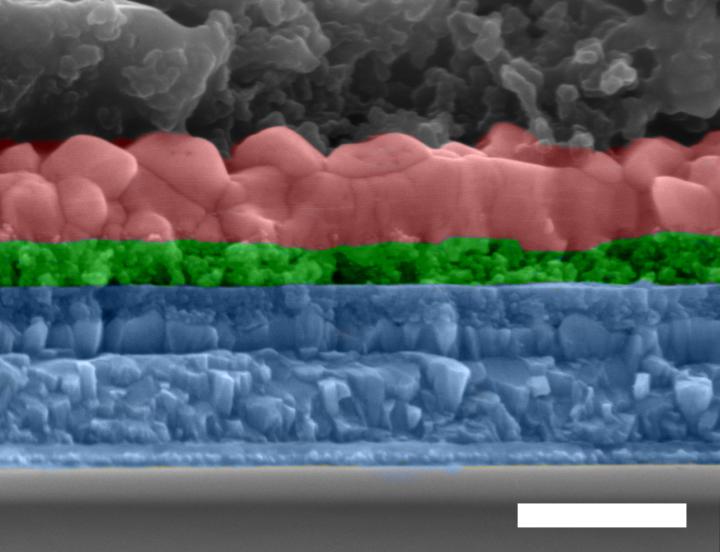

An electron microscope image shows a cross-section of the all-inorganic perovskite solar cell developed at Rice University. From top, the layers are a carbon electrode, perovskite, titanium oxide, fluorine-doped tin oxide and glass. The scale bar equals 500 nanometers.
Credit: Lou Group/Rice University
Rice University scientists believe they've overcome a major hurdle keeping perovskite-based solar cells from achieving mainstream use.
Through the strategic use of the element indium to replace some of the lead in perovskites, Rice materials scientist Jun Lou and his colleagues at the Brown School of Engineering say they're better able to engineer the defects in cesium-lead-iodide solar cells that affect the compound's band gap, a critical property in solar cell efficiency.
As a side benefit, the lab's newly formulated cells can be made in open air and last for months rather than days with a solar conversion efficiency slightly above 12%.
The Rice team's results appear in Advanced Materials.
Perovskites are crystals with cubelike lattices that are known to be efficient light harvesters, but the materials tend to be stressed by light, humidity and heat.
Not the Rice perovskites, Lou said.
“From our perspective, this is something new and I think it represents an important breakthrough,” he said. “This is different from the traditional, mainstream perovskites people have been talking about for 10 years — the inorganic-organic hybrids that give you the highest efficiency so far recorded, about 25%. But the issue with that type of material is its instability.
“Engineers are developing capping layers and things to protect those precious, sensitive materials from the environment,” Lou said. “But it's hard to make a difference with the intrinsically unstable materials themselves. That's why we set out to do something different.”
Rice postdoctoral researcher and lead author Jia Liang and his team built and tested perovskite solar cells of inorganic cesium, lead and iodide, the very cells that tend to fail quickly due to defects. But by adding bromine and indium, the researchers were able to quash defects in the material, raising the efficiency above 12% and the voltage to 1.20 volts.
As a bonus, the material proved to be exceptionally stable. The cells were prepared in ambient conditions, standing up to Houston's high humidity, and encapsulated cells remained stable in air for more than two months, far better than the few days that plain cesium-lead-iodide cells lasted.
“The highest efficiency for this material may be about 20%, and if we can get there, this can be a commercial product,” Liang said. “It has advantages over silicon-based solar cells because synthesis is very cheap, it's solution-based and easy to scale up. Basically, you just spread it on a substrate, let it dry out, and you have your solar cell.”
###
Co-authors of the paper are Xiao Han of Northwestern Polytechnical University, China; Ji-Hui Yang of Fudan University, Shanghai; and Rice graduate students Boyu Zhang, Qiyi Fang, Meredith Ogle, postdoctoral researcher Jing Zhang, academic visitor Qing Ai, research specialist Tanguy Terlier and Angel Martí, an associate professor of chemistry, of bioengineering and of materials science and nanoengineering. Lou is a professor of materials science and nanoengineering, and of chemistry.
The Peter M. and Ruth L. Nicholas Postdoctoral Fellowship in Nanotechnology, the Welch Foundation, the China Scholarship Council and the National Science Foundation supported the research.
Read the abstract at https:/
This news release can be found online at https:/
Follow Rice News and Media Relations via Twitter @RiceUNews.
Related materials:
Lou Group: https:/
Rice Department of Materials Science and NanoEngineering: https:/
George R. Brown School of Engineering: https:/
Images for download:
https:/
Rice University postdoctoral researcher Jia Liang holds perovskite solar cells developed with all inorganic materials. Controlling defects in the cells by eliminating organic components made them more robust while retaining their power conversion efficiency. (Credit: Jeff Fitlow/Rice University)
https:/
A sample all-inorganic perovskite solar cell is a step toward commercial use, according to scientists at Rice University. Their discovery of a way to quench defects in cesium-lead-iodide solar cells allowed them to preserve the material's band gap, a critical property in solar cell efficiency. (Credit: Jeff Fitlow/Rice University)
https:/
A schematic view shows an all-inorganic perovskite solar cell developed by materials scientists at Rice University. (Credit: Lou Group/Rice University)
https:/
An electron microscope image shows a cross-section of the all-inorganic perovskite solar cell developed at Rice University. From top, the layers are a carbon electrode, perovskite, titanium oxide, fluorine-doped tin oxide and glass. The scale bar equals 500 nanometers. (Credit: Lou Group/Rice University)Located on a 300-acre forested campus in Houston, Rice University is consistently ranked among the nation's top 20 universities by U.S. News & World Report. Rice has highly respected schools of Architecture, Business, Continuing Studies, Engineering, Humanities, Music, Natural Sciences and Social Sciences and is home to the Baker Institute for Public Policy. With 3,962 undergraduates and 3,027 graduate students, Rice's undergraduate student-to-faculty ratio is just under 6-to-1. Its residential college system builds close-knit communities and lifelong friendships, just one reason why Rice is ranked No. 1 for lots of race/class interaction and No. 4 for quality of life by the Princeton Review. Rice is also rated as a best value among private universities by Kiplinger's Personal Finance.
Contacts:
Jeff Falk
713-348-6775
jfalk@rice.edu
Mike Williams
713-348-6728
mikewilliams@rice.edu












